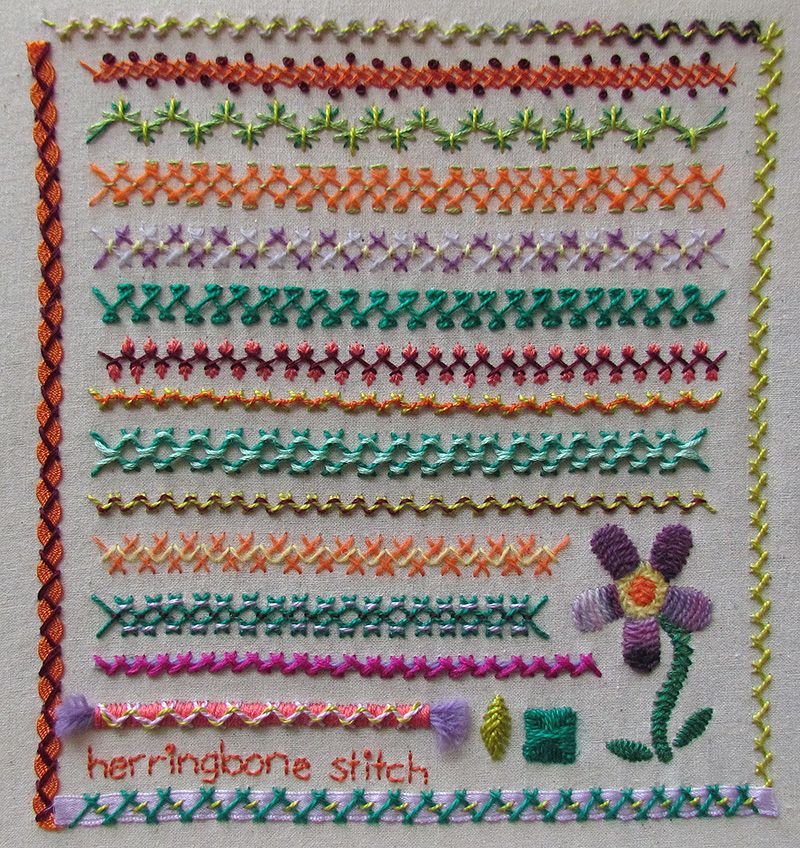This week’s Take a Stitch on Tuesday sampler does not contain a fish of any sort, which is kind of ironic, considering it’s herringbone stitch.

I really struggled with working a few variations of herringbone stitch that I had really wanted to try. You won’t see them in the sampler because I either gave up when I couldn’t get it to look good with the threads I tried, or I’d worked the whole foundation row of herringbone stitch without noticing I was supposed to pass the needle under a thread somewhere strange and I did it the regular way. I’m looking at you laced herringbone stitch and interlaced herringbone stitch :-/
Hmm, I wish I’d found those tutorials before. They’re different to the instructions in my embroidery encyclopaedia and use basic herringbone bases instead of the “don’t forget to pass your needle under 8,000 threads and make your head explode” version I have. OK, it was just one thread but still.
I do like what I ended up with, despite not being able to get my head around the versions I really wanted to try (I’ll be having another go)!
The stitches in my sampler are (from the Batsford Ecyclopaedia of Embroidery Stitches by Anne Butler or made up on the spot by me out of frustration when trying to work the above mentioned stitches):
- Top: threaded herringbone stitch
- Right: herringbone stitch
- Bottom: ribbon couched with herringbone stitch with one leg tied down with a straight stitch
- Left: ric-rac couched with herringbone stitch
- From top to bottom: Double back stitch with french knots. Double back stitch is basically herringbone with the tops of the crosses touching. The back looks like two rows of back stitch.
- Double herringbone stitch with a straight stitch up the centre of each cross.
- Two rows of herringbone on top of each other with running stitch to close the tops of the crosses and tie down the centre.
- Two rows of herringbone on top of each other with the centre tacked down with cross stitch
- Back stitched herringbone stitch
- Herringbone and spike stitch
- Tied herringbone stitch
- Twisted lattice band
- Threaded herringbone stitch again 🙂
- Herringbone stitch tied down with zig zag stitch (worked as a row straight stitches tying down the centre of one leg, then back again across the other leg).
- Two layers of herringbone tied down with running stitch wherever threads crossed
- Tapestry wool couched with herringbone stitch
- Raised lace band stitch. The satin stitch foundation was worked over 4 threads of tapestry wool.
- The leaf shape is raised close herringbone stitch
- The square is square herringbone stitch and
- The flower is close herringbone stitch
Things I learnt from this sampler:
- Trying to work square herringbone stitch at 1:30 am when you have insomnia caused by vertigo will result in a wonky square no matter how many times you rip it out and start again. I wonder if larger squares like mine would benefit from a border of split stitch to define the square before working, like you would with satin stitch.
- Square herringbone stitch would make a kick-arse check filling and is worth the trouble. I wonder what sort of patterns you could make on gingham with it.
- Tied herringbone stitch is ugly in very short rows but nice in longer rows. When working the tied portion, always tighten the knots by pulling the thread towards the outer edge of the stitch if you want to create a zig-zag, or towards the centre if you want to force it into a straighter line.
- Twisted lattice band stitch really stands up from the fabric when worked in thicker threads (in this case perle 5 mercerised cotton laced with 6 strands of embroidery floss).
- Ric-rac couched with herringbone would be a great base for lots of fancy borders.
- Leaves worked in raised close herringbone stitch are amazingly three dimensional.
- I like close herringbone stitch as a filling worked with crewel wool more than cotton floss. Wool fills better but floss is more graphic.
- Herringbone stitch is really good at being super fancy with lacing, threading, couching and the addition of other stitches.
Stitches I still want to try:
- Interlaced and laced herringbone stitch using the tutorials linked above
- Point de reprise stitch
- Buttonholed herringbone stitch and
- Two different stitches called fancy herringbone stitch.
See what happens when I don’t work two samplers? I still want to try more stitches…
Some useful links:
TAST on Facebook
Sharron’s TAST FAQ on her website, Pintangle.
Free vintage stitch book downloads.


Pingback:Flätsöm